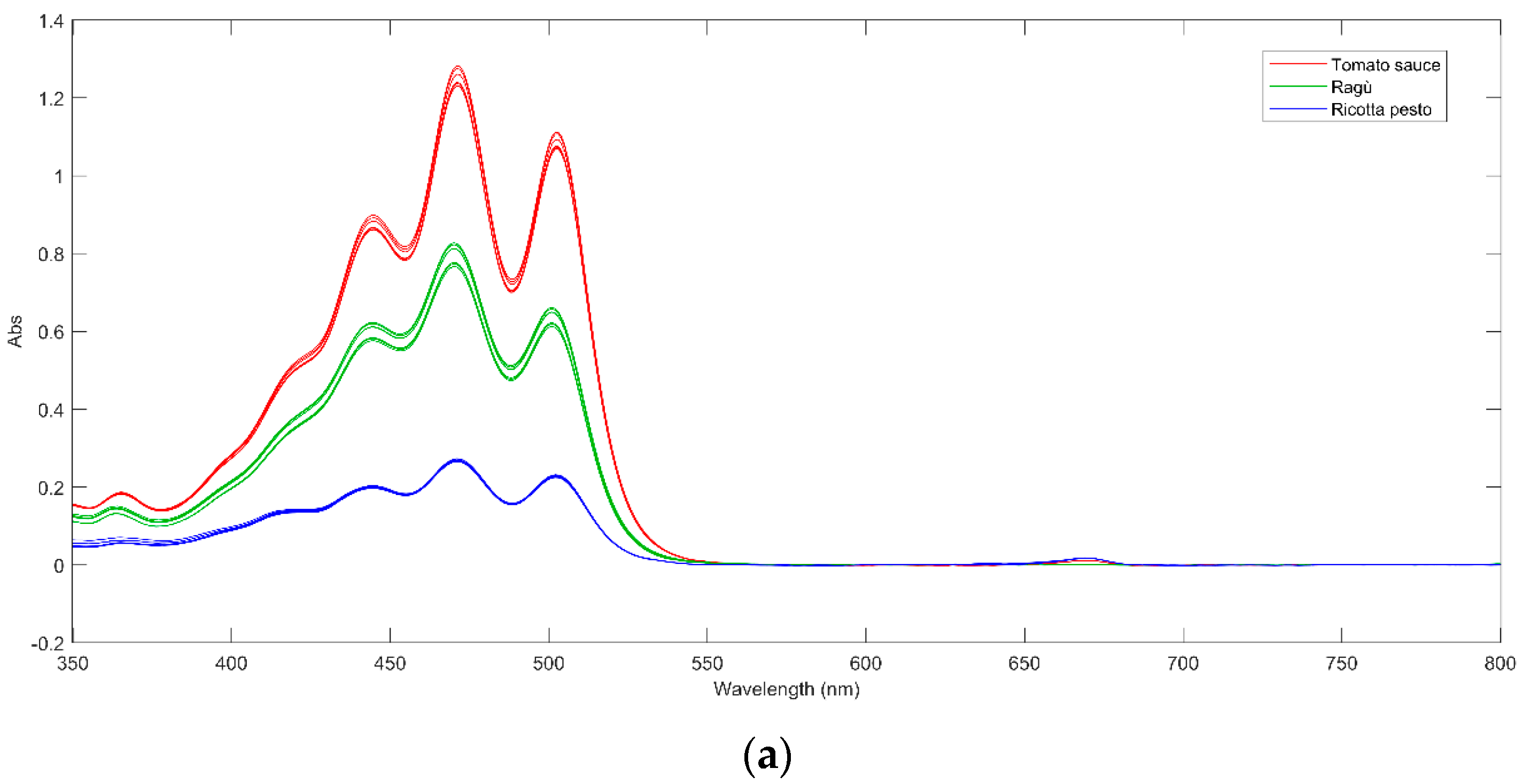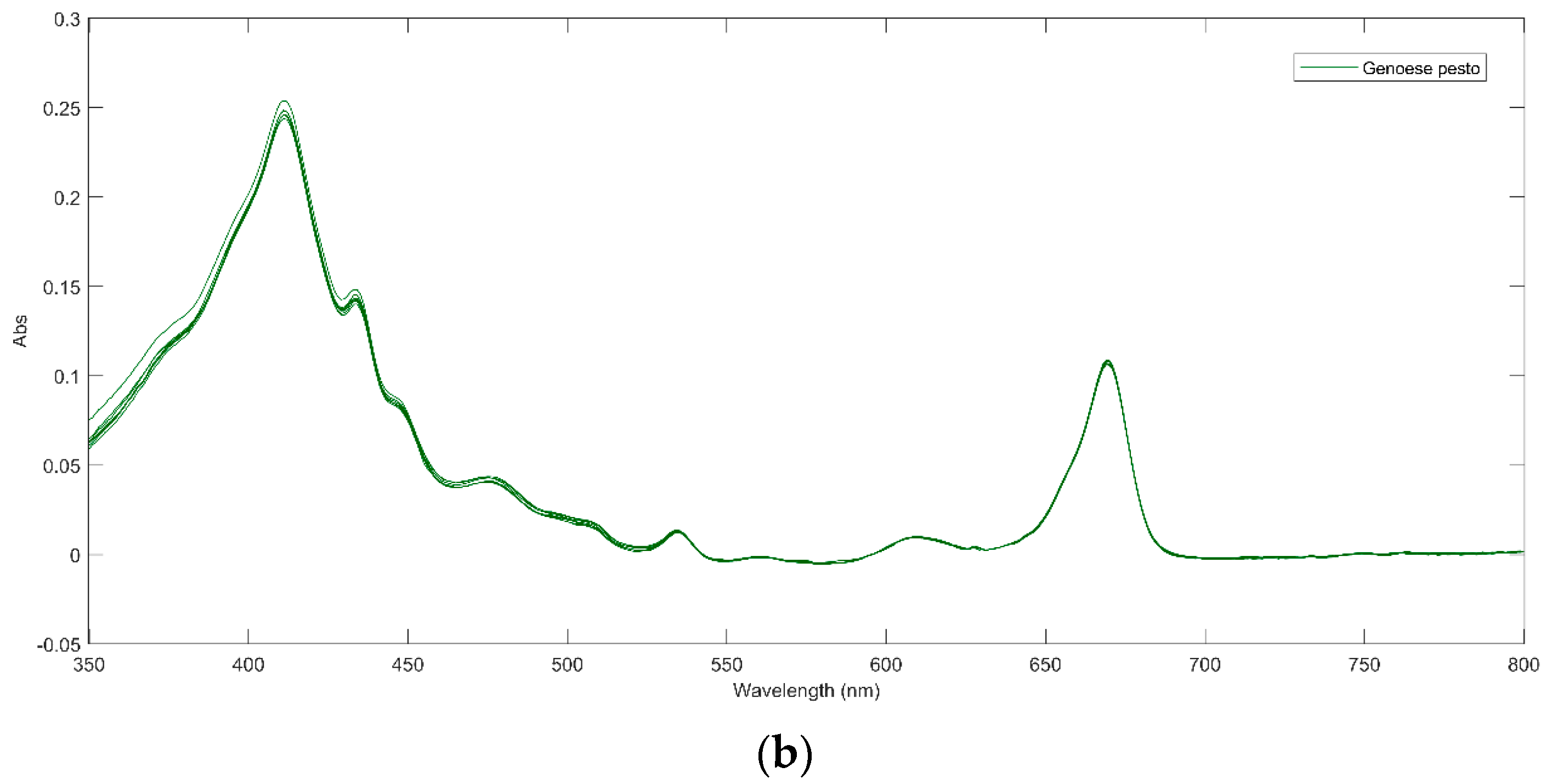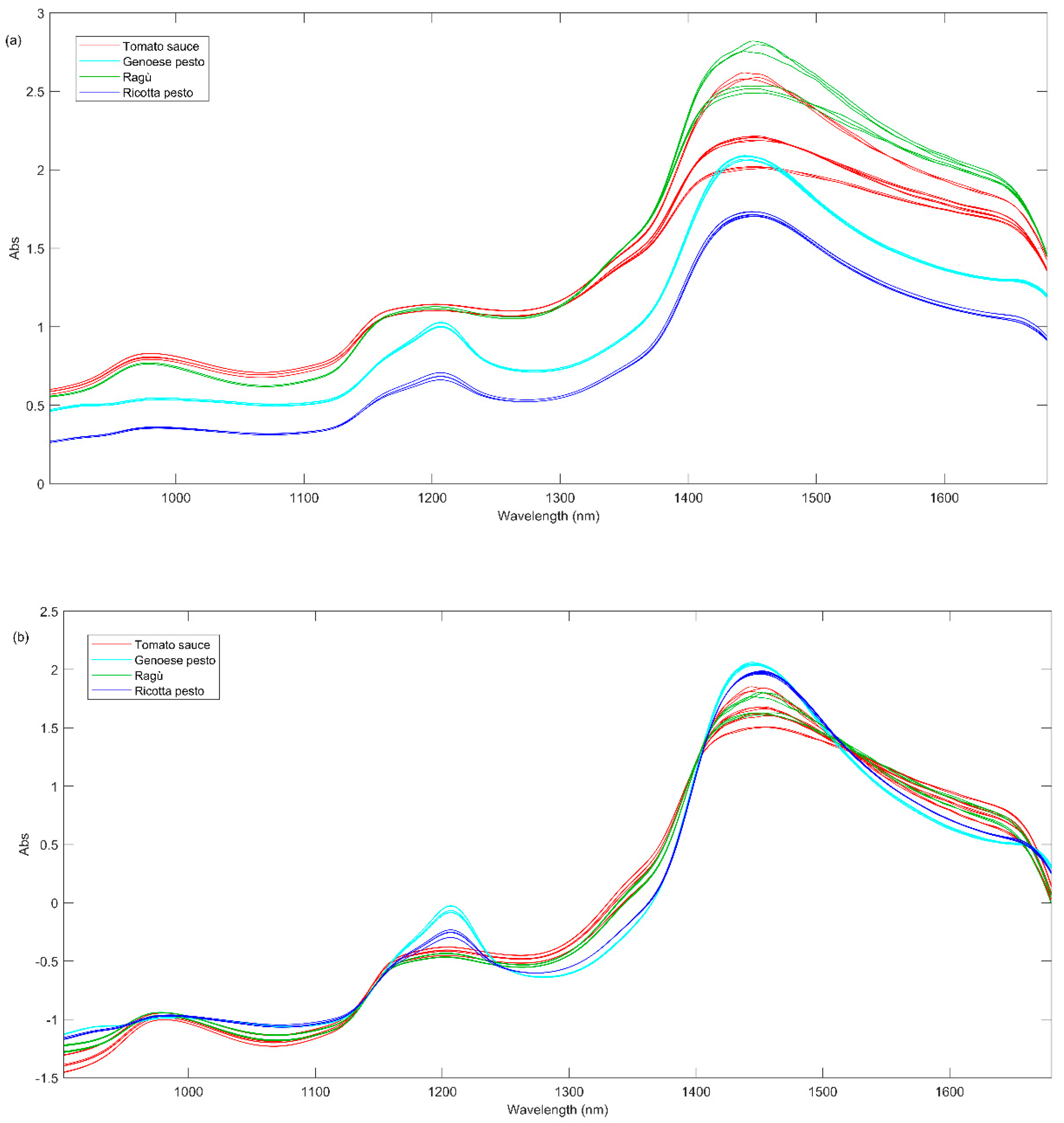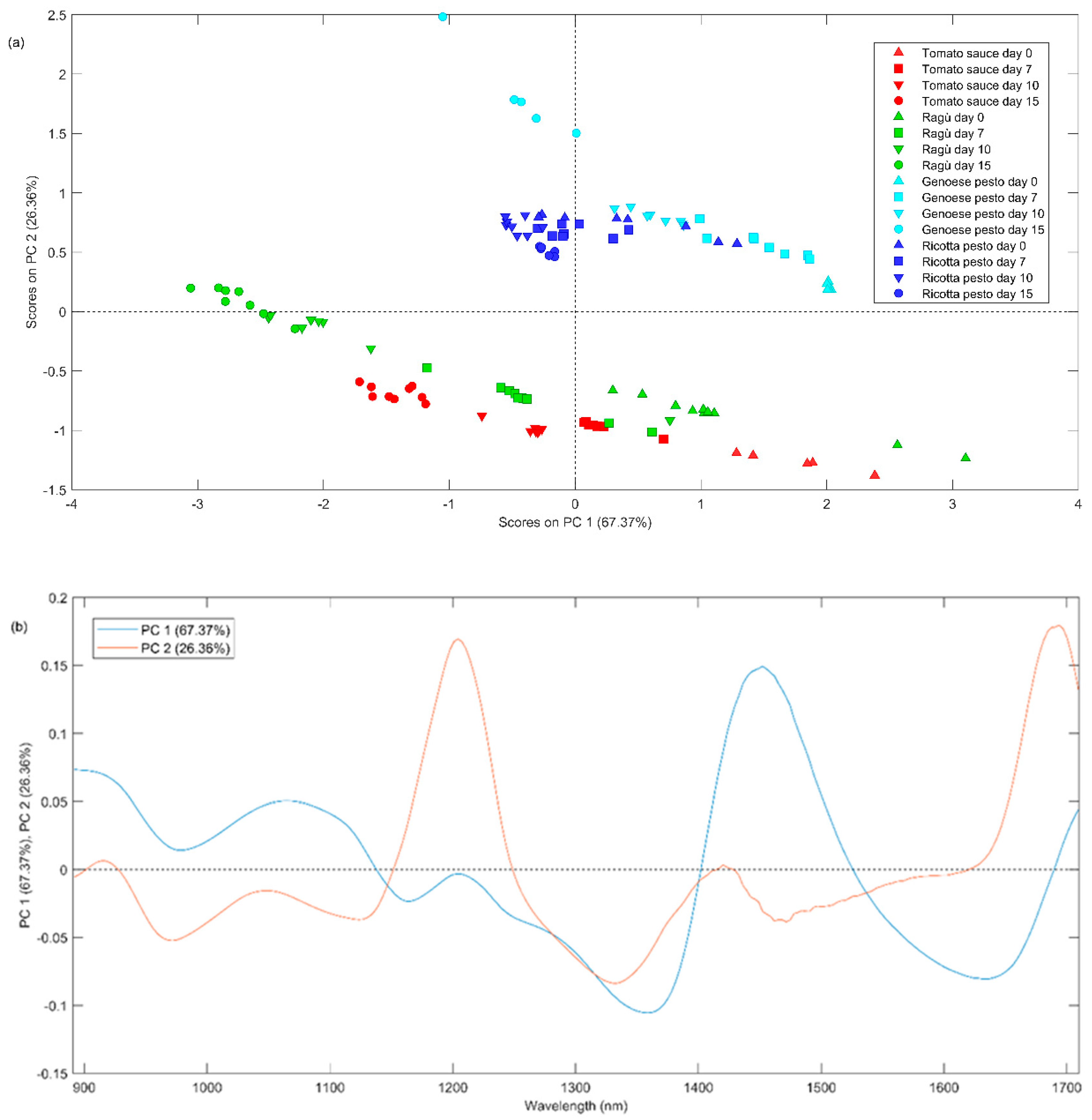Chemical Characterization and Temporal Variability of Pasta Condiment By-Products for Sustainable Waste Management
Abstract
1. Introduction
2. Materials and Methods
2.1. Chemicals
2.2. Samples and Storage Conditions
2.3. Determination of pH
2.4. Determination of Total Phenolic Content
2.5. Qualitative Determination of Lycopene
2.6. Near-Infrared Analysis
2.7. Determination of the Volatile Fraction by SPME-GC-MS
2.8. Data Analysis
2.9. Software
3. Results
3.1. pH and Total Phenolic Content
3.2. Qualitative Lycopene Analysis Results
3.3. NIR Spectra Analysis
3.4. Putatively Identification of the Volatile Compounds by SPME-GC-MS
4. Conclusions
Supplementary Materials
Author Contributions
Funding
Data Availability Statement
Conflicts of Interest
References
- Conti, V.; Romi, M.; Parri, S.; Aloisi, I.; Marino, G.; Cai, G.; Cantini, C. Morpho-Physiological Classification of Italian Tomato Cultivars (Solanum lycopersicum L.) According to Drought Tolerance during Vegetative and Reproductive Growth. Plants 2021, 10, 1826. [Google Scholar] [CrossRef] [PubMed]
- Secondi, L.; Principato, L.; Ruini, L.; Guidi, M. Reusing Food Waste in Food Manufacturing Companies: The Case of the Tomato-Sauce Supply Chain. Sustainability 2019, 11, 2154. [Google Scholar] [CrossRef]
- Eslami, E.; Carpentieri, S.; Pataro, G.; Ferrari, G. A Comprehensive Overview of Tomato Processing By-Product Valorization by Conventional Methods versus Emerging Technologies. Foods 2023, 12, 166. [Google Scholar] [CrossRef] [PubMed]
- Benítez, J.J.; Castillo, P.M.; Del Río, J.C.; León-Camacho, M.; Domínguez, E.; Heredia, A.; Guzmán-Puyol, S.; Athanassiou, A.; Heredia-Guerrero, J.A. Valorization of Tomato Processing By-Products: Fatty Acid Extraction and Production of Bio-Based Materials. Materials 2018, 11, 2211. [Google Scholar] [CrossRef]
- Coelho, M.C.; Rodrigues, A.S.; Teixeira, J.A.; Pintado, M.E. Integral Valorisation of Tomato By-Products towards Bioactive Compounds Recovery: Human Health Benefits. Food Chem. 2023, 410, 135319. [Google Scholar] [CrossRef]
- Kaboré, K.; Konaté, K.; Sanou, A.; Dakuyo, R.; Sama, H.; Santara, B.; Compaoré, E.W.R.; Dicko, M.H. Tomato By-Products, a Source of Nutrients for the Prevention and Reduction of Malnutrition. Nutrients 2022, 14, 2871. [Google Scholar] [CrossRef]
- Martínez-Valverde, I.; Periago, M.J.; Provan, G.; Chesson, A. Phenolic Compounds, Lycopene and Antioxidant Activity in Commercial Varieties of Tomato (Lycopersicum esculentum). J. Sci. Food Agric. 2002, 82, 323–330. [Google Scholar] [CrossRef]
- Szabo, K.; Cătoi, A.-F.; Vodnar, D.C. Bioactive Compounds Extracted from Tomato Processing By-Products as a Source of Valuable Nutrients. Plant Foods Hum. Nutr. Dordr. Neth. 2018, 73, 268–277. [Google Scholar] [CrossRef]
- Viuda-Martos, M.; Sanchez-Zapata, E.; Sayas-Barberá, E.; Sendra, E.; Pérez-Álvarez, J.A.; Fernández-López, J. Tomato and Tomato Byproducts. Human Health Benefits of Lycopene and Its Application to Meat Products: A Review. Crit. Rev. Food Sci. Nutr. 2014, 54, 1032–1049. [Google Scholar] [CrossRef]
- Omoni, A.O.; Aluko, R.E. The Anti-Carcinogenic and Anti-Atherogenic Effects of Lycopene: A Review. Trends Food Sci. Technol. 2005, 16, 344–350. [Google Scholar] [CrossRef]
- Stagos, D.; Amoutzias, G.D.; Matakos, A.; Spyrou, A.; Tsatsakis, A.M.; Kouretas, D. Chemoprevention of Liver Cancer by Plant Polyphenols. Food Chem. Toxicol. 2012, 50, 2155–2170. [Google Scholar] [CrossRef] [PubMed]
- Nour, V.; Panaite, T.D.; Ropota, M.; Turcu, R.; Trandafir, I.; Corbu, A.R. Nutritional and Bioactive Compounds in Dried Tomato Processing Waste. CYTA J. Food 2018, 16, 222–229. [Google Scholar] [CrossRef]
- Stewart, A.J.; Bozonnet, S.; Mullen, W.; Jenkins, G.I.; Lean, M.E.; Crozier, A. Occurrence of Flavonols in Tomatoes and Tomato-Based Products. J. Agric. Food Chem. 2000, 48, 2663–2669. [Google Scholar] [CrossRef] [PubMed]
- Farinon, B.; Felli, M.; Sulli, M.; Diretto, G.; Savatin, D.V.; Mazzucato, A.; Merendino, N.; Costantini, L. Tomato Pomace Food Waste from Different Variants as a High Antioxidant Potential Resource. Food Chem. 2024, 452, 139509. [Google Scholar] [CrossRef] [PubMed]
- Ouatmani, T.; Haddadi-Guemghar, H.; Hadjal, S.; Boulekbache-Makhlouf, L.; Madani, K. Tomato By-Products: A Potentially Promising Bioresource for the Recovery of Bioactive Compounds and Nutraceuticals. In Nutraceutics from Agri-Food By-Products; Wiley: Hoboken, NJ, USA, 2023; pp. 137–171. [Google Scholar]
- Clément, A.; Dorais, M.; Vernon, M. Multivariate Approach to the Measurement of Tomato Maturity and Gustatory Attributes and Their Rapid Assessment by Vis−NIR Spectroscopy. J. Agric. Food Chem. 2008, 56, 1538–1544. [Google Scholar] [CrossRef]
- Pellacani, S.; Cocchi, M.; Durante, C.; Strani, L. Exploring the Effect of Different Storage Conditions on the Aroma Profile of Bread by Using Arrow-SPME GC-MS and Chemometrics. Molecules 2023, 28, 3587. [Google Scholar] [CrossRef]
- Baccolo, G.; Quintanilla-Casas, B.; Vichi, S.; Augustijn, D.; Bro, R. From Untargeted Chemical Profiling to Peak Tables—A Fully Automated AI Driven Approach to Untargeted GC-MS. TrAC Trends Anal. Chem. 2021, 145, 116451. [Google Scholar] [CrossRef]
- Pellacani, S.; Durante, C.; Celli, S.; Mariani, M.; Marchetti, A.; Cocchi, M.; Strani, L. Optimization of an Analytical Method Based on SPME-Arrow and Chemometrics for the Characterization of the Aroma Profile of Commercial Bread. Chemom. Intell. Lab. Syst. 2023, 241, 104940. [Google Scholar] [CrossRef]
- Li Vigni, M.; Durante, C.; Cocchi, M. Data Handling in Science and Technology. In Chemometrics in Food Chemistry; Chapter 3—Exploratory Data Analysis; Marini, F., Ed.; Elsevier: Amsterdam, The Netherlands, 2013; Voluem 28, pp. 55–126. [Google Scholar]
- ASTM D1193—91; Test Method for Oxygen Gas Transmission Rate Through Plastic Film and Sheeting Using a Coulometric Sensor. A Novel NIR Spectroscopic Method for Rapid Analyses of Lycopene, Total Acid, Sugar, Phenols and Antioxidant Activity in Dehydrated Tomato Samples. ASTM International: West Conshohocken, PA, USA, 2017. [CrossRef]
- Ding, X.; Guo, Y.; Ni, Y.; Kokot, S. A Novel NIR Spectroscopic Method for Rapid Analyses of Lycopene, Total Acid, Sugar, Phenols and Antioxidant Activity in Dehydrated Tomato Samples. Vib. Spectrosc. 2016, 82, 1–9. [Google Scholar] [CrossRef]
- Zardetto, S.; Barbanti, D. Shelf Life Assessment of Fresh Green Pesto Using an Accelerated Test Approach. Food Packag. Shelf Life 2020, 25, 100524. [Google Scholar] [CrossRef]
- Santos, J.E.; Villarino, B.; Zosa, A.; Dayrit, F. Analysis of Volatile Organic Compounds in Virgin Coconut Oil and Their Sensory Attibutes. Philipp. J. Sci. 2011, 140, 161–171. [Google Scholar]
- Commission Regulation (EEC) No 1764/86 of 27 May 1986 on Minimum Quality Requirements for Tomato-Based Products Eligible for Production Aid. 1986, Volume 153. Available online: https://eur-lex.europa.eu/LexUriServ/LexUriServ.do?uri=CELEX:31986R1764:EN:pdf (accessed on 19 July 2024).
- Díaz, P.; Garrido, M.D.; Bañón, S. The Effects of Packaging Method (Vacuum Pouch vs. Plastic Tray) on Spoilage in a Cook-Chill Pork-Based Dish Kept under Refrigeration. Meat Sci. 2010, 84, 538–544. [Google Scholar] [CrossRef] [PubMed]
- Nicosia, C.; Mezza, I.; Pulvirenti, A.; Licciardello, F. Assessment of the Secondary Shelf Life of Bolognese Sauce Based on Domestic Use Simulation. Food Packag. Shelf Life 2023, 40, 101172. [Google Scholar] [CrossRef]
- Vallverdú-Queralt, A.; Arranz, S.; Medina-Remón, A.; Casals-Ribes, I.; Lamuela-Raventós, R.M. Changes in Phenolic Content of Tomato Products during Storage. J. Agric. Food Chem. 2011, 59, 9358–9365. [Google Scholar] [CrossRef] [PubMed]
- Perea-Domínguez, X.P.; Hernández-Gastelum, L.Z.; Olivas-Olguin, H.R.; Espinosa-Alonso, L.G.; Valdez-Morales, M.; Medina-Godoy, S. Phenolic Composition of Tomato Varieties and an Industrial Tomato By-Product: Free, Conjugated and Bound Phenolics and Antioxidant Activity. J. Food Sci. Technol. 2018, 55, 3453–3461. [Google Scholar] [CrossRef]
- Lavelli, V.; Peri, C.; Rizzolo, A. Antioxidant Activity of Tomato Products as Studied by Model Reactions Using Xanthine Oxidase, Myeloperoxidase, and Copper-Induced Lipid Peroxidation. J. Agric. Food Chem. 2000, 48, 1442–1448. [Google Scholar] [CrossRef]
- Górecka, D.; Wawrzyniak, A.; Jędrusek-Golińska, A.; Dziedzic, K.; Hamułka, J.; Kowalczewski, P.Ł.; Walkowiak, J. Lycopene in Tomatoes and Tomato Products. Open Chem. 2020, 18, 752–756. [Google Scholar] [CrossRef]
- Masino, F.; Ulrici, A.; Antonelli, A. Extraction and Quantification of Main Pigments in Pesto Sauces. Eur. Food Res. Technol. 2008, 226, 569–575. [Google Scholar] [CrossRef]
- Borello, E.; Roncucci, D.; Domenici, V. Study of the Evolution of Pigments from Freshly Pressed to ‘On-the-Shelf’ Extra-Virgin Olive Oils by Means of Near-UV Visible Spectroscopy. Foods 2021, 10, 1891. [Google Scholar] [CrossRef]
- Shi, J.; Le Maguer, M. Lycopene in Tomatoes: Chemical and Physical Properties Affected by Food Processing. Crit. Rev. Biotechnol. 2000, 20, 293–334. [Google Scholar] [CrossRef]
- Workman, J. Spectral Interpretation. In Handbook of Near-Infrared Analysis; CRC Press: Boca Raton, FL, USA, 2021; ISBN 978-1-351-26988-9. [Google Scholar]
- Strani, L.; D’Alessandro, A.; Ballestrieri, D.; Durante, C.; Cocchi, M. Fast GC E-Nose and Chemometrics for the Rapid Assessment of Basil Aroma. Chemosensors 2022, 10, 105. [Google Scholar] [CrossRef]
- Hyldgaard, M.; Mygind, T.; Meyer, R.L. Essential Oils in Food Preservation: Mode of Action, Synergies, and Interactions with Food Matrix Components. Front. Microbiol. 2012, 3, 12. [Google Scholar] [CrossRef] [PubMed]
- Falleh, H.; Ben Jemaa, M.; Saada, M.; Ksouri, R. Essential Oils: A Promising Eco-Friendly Food Preservative. Food Chem. 2020, 330, 127268. [Google Scholar] [CrossRef] [PubMed]
- Fongang Fotsing, Y.S.; Kezetas Bankeu, J.J. Terpenoids as Important Bioactive Constituents of Essential Oils. In Essential oils—Bioactive Compounds, New Perspectives and Application; Intech Open: London, UK, 2020. [Google Scholar]
- Amadei, G.; Ross, B.M. Quantification of Character-Impacting Compounds in Ocimum Basilicum and “Pesto Alla Genovese” with Selected Ion Flow Tube Mass Spectrometry. Rapid Commun. Mass Spectrom. 2012, 26, 219–225. [Google Scholar] [CrossRef] [PubMed]
- Salvadeo, P.; Boggia, R.; Evangelisti, F.; Zunin, P. Analysis of the Volatile Fraction of “Pesto Genovese” by Headspace Sorptive Extraction (HSSE). Food Chem. 2007, 105, 1228–1235. [Google Scholar] [CrossRef]
- Saini, R.K.; Bekhit, A.A.E.-D.; Roohinejad, S.; Rengasamy, K.R.R.; Keum, Y.-S. Chemical Stability of Lycopene in Processed Products: A Review of the Effects of Processing Methods and Modern Preservation Strategies. J. Agric. Food Chem. 2020, 68, 712–726. [Google Scholar] [CrossRef]
- Shi, K.; Hu, T.; Zhang, P.; Zhang, S.; Xu, Y.; Zhang, Z.; Pan, S. Thermal Conditions and Active Substance Stability Affect the Isomerization and Degradation of Lycopene. Food Res. Int. 2022, 162, 111987. [Google Scholar] [CrossRef]







| Compound Name | Match Factor | Retention Time (min) |
|---|---|---|
| Acetic acid | 96 | 8.87 |
| 3-methyl-Butanal | 90 | 9.39 |
| Heptane | 88 | 12.41 |
| 4-methyl-2-Pentanol | 92 | 13.98 |
| Octane | 94 | 16.57 |
| (Z)-3-Hexen-1-ol | 96 | 18.31 |
| 1-Hexanol | 87 | 18.87 |
| 1,3-dimethyl-benzene | 96 | 19.40 |
| Heptanal | 90 | 20.23 |
| Nonane | 86 | 21.14 |
| (E)-2-Heptenal | 93 | 22.66 |
| Benzaldehyde | 87 | 22.83 |
| α-Pinene | 95 | 22.94 |
| Hexanoic acid | 97 | 23.37 |
| Heptanol | 96 | 23.50 |
| Camphene | 95 | 23.64 |
| 6-Methyl-5-hepten-2-one | 92 | 23.99 |
| Sabinene | 93 | 24.45 |
| Myrcene | 97 | 24.88 |
| 2-β-Pinene | 91 | 24.81 |
| (Z)-3-Hexen-1-ol acetate | 85 | 24.94 |
| Octanal | 93 | 24.81 |
| 2-ethyl-1-hexanol, | 85 | 26.15 |
| Benzeneacetaldehyde | 87 | 26.29 |
| P-Cymene | 93 | 26.42 |
| Limonene | 95 | 26.86 |
| Eucalyptol | 98 | 26.91 |
| 2-Octenal | 93 | 27.10 |
| δ-3-Carene | 96 | 27.24 |
| Heptanoic acid | 87 | 27.46 |
| n-Octanol | 92 | 27.80 |
| γ-Terpinene | 93 | 27.97 |
| Nonanal | 96 | 29.19 |
| Linalool | 94 | 29.22 |
| Benzeneethanol | 93 | 29.44 |
| p-Cymenene | 86 | 28.98 |
| p-Mentha-1,5,8-triene | 95 | 30.02 |
| Nonenal | 96 | 31.10 |
| (+)-camphor | 94 | 31.12 |
| Octanoic acid | 85 | 31.20 |
| (−)-Borneol | 92 | 31.99 |
| 3-Pinanone | 86 | 32.07 |
| 5-(hydroxymethyl)-2-Furancarboxaldehyde | 96 | 32.30 |
| δ-Terpineol | 87 | 32.26 |
| Estragole | 93 | 32.53 |
| (−)-α-Terpineol | 93 | 32.55 |
| n-Decanal | 86 | 32.64 |
| (+)-Verbenone | 96 | 32.97 |
| Dodecane | 86 | 33.00 |
| Neral | 88 | 33.64 |
| 2-Phenylethyl acetate | 96 | 33.95 |
| Nonanoic acid | 96 | 34.08 |
| (E)-2-Decenal | 97 | 34.19 |
| Geranial | 85 | 34.35 |
| (E,E)-2,4-Decadienal | 86 | 35.03 |
| Carvacrol | 95 | 35.14 |
| (−)-Bornyl acetate | 96 | 35.27 |
| Undecanal | 86 | 35.39 |
| Triacetin | 85 | 35.53 |
| Decanoic acid | 87 | 36.48 |
| Eugenol | 98 | 36.56 |
| 2-Undecenal | 96 | 36.72 |
| Methyleugenol | 85 | 37.31 |
| β-Elemene | 93 | 38.01 |
| Caryophyllene | 96 | 38.85 |
| α-Bergamotene | 96 | 38.85 |
| α-Humulene | 90 | 39.49 |
| (E)-β-Farnesene | 88 | 39.79 |
| Myristicin | 96 | 39.83 |
| β-Cubebene | 85 | 39.92 |
| Lauric acid | 86 | 40.37 |
| Myristic acid | 86 | 43.84 |
| Palmitic acid | 96 | 48.48 |
| Palmitic acid, ethyl ester | 86 | 49.64 |
| (Z,Z)-9,12-Octadecadienoic acid | 85 | 54.43 |
| cis-13-Octadecenoic acid | 96 | 54.74 |
| Stearic acid | 86 | 55.59 |
| Oleic acid, ethyl ester | 95 | 56.19 |
Disclaimer/Publisher’s Note: The statements, opinions and data contained in all publications are solely those of the individual author(s) and contributor(s) and not of MDPI and/or the editor(s). MDPI and/or the editor(s) disclaim responsibility for any injury to people or property resulting from any ideas, methods, instructions or products referred to in the content. |
© 2024 by the authors. Licensee MDPI, Basel, Switzerland. This article is an open access article distributed under the terms and conditions of the Creative Commons Attribution (CC BY) license (https://creativecommons.org/licenses/by/4.0/).
Share and Cite
Strani, L.; Farioli, G.; Cocchi, M.; Durante, C.; Olarini, A.; Pellacani, S. Chemical Characterization and Temporal Variability of Pasta Condiment By-Products for Sustainable Waste Management. Foods 2024, 13, 3018. https://doi.org/10.3390/foods13183018
Strani L, Farioli G, Cocchi M, Durante C, Olarini A, Pellacani S. Chemical Characterization and Temporal Variability of Pasta Condiment By-Products for Sustainable Waste Management. Foods. 2024; 13(18):3018. https://doi.org/10.3390/foods13183018
Chicago/Turabian StyleStrani, Lorenzo, Giulia Farioli, Marina Cocchi, Caterina Durante, Alessandra Olarini, and Samuele Pellacani. 2024. "Chemical Characterization and Temporal Variability of Pasta Condiment By-Products for Sustainable Waste Management" Foods 13, no. 18: 3018. https://doi.org/10.3390/foods13183018
APA StyleStrani, L., Farioli, G., Cocchi, M., Durante, C., Olarini, A., & Pellacani, S. (2024). Chemical Characterization and Temporal Variability of Pasta Condiment By-Products for Sustainable Waste Management. Foods, 13(18), 3018. https://doi.org/10.3390/foods13183018







